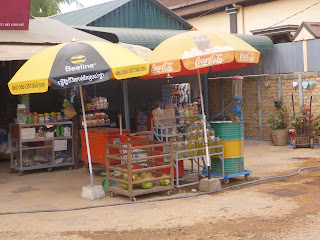Today the owner of my guesthouse took me on a "motorbike mystery tour" to the countryside surrounding Siem Reap. The tour is designed to give an insight into the real Cambodia - how people outside of the tourist madness in Siem Reap really live.
Our first stop after about 45 minutes on dusty dirt roads was a Buddhist temple. The monks, having heard our motorbike approach, all went into hiding - according to my guide, this is what they always do. They don't seem to be of the talkative sort at this temple. Which really didn't surprise my all that much once the motorbike's engine had been turned off: there was such a profound silence around the pagoda, broken only by insects and the occasional rooster, that I can't condemn the monks for wanting to keep it.
One of the temple's buildings had bullet holes all over - remains from the Pol Pot era, without doubt. Another had this lovely carved lintel which I found was quite similar to the lintels on display in the Angkor National Museum.
A third of the buildings was covered with extremely bright paintings - there must have been a surplus of neon colors somewhere ;-)
The temple was surrounded by the typical landscape in this part of Cambodia: rice fields as far as the eye can see...
... water-filled fields with lotus flowers (the stems of which are a popular vegetable), and water buffaloes grazing in recently harvested fields:
We also passed several villages, all with different building styles and levels of wealth and cleanliness. The inhabitants of this village, for example, seem to be very afraid of evil spirits. As a result, every house has at least one scarecrow standing in front of it to keep the spirits away. The scarecrows are all quite realistic: they have the correct height, wear human clothes and shoes, and even have faces of some sort. This picture shows a pair of these scarecrows:
From a small hill, we had a good view of villages in the area. Many of the villages are built on stilts, like in this picture:
Since it is dry season right now, the stilts seem to be there for no purpose at all. A closer look, however, reveals that the water marks left by previous floods reach well up the stilts, four meters or more above the ground.
Dry season also has another effect: many of the roads in the countryside are not paved, but dirt roads in various states of repair. The roads reveal the color of the earth, which is a yellowish-brown in most cases. Some of the roads are bright red, however, and this red dust settles on everything - coloring even the roadside plants:
Being in the vicinity of Angkor Wat, we also came upon some temple ruins. This one was allegedly built as a trial run for Angkor Wat:
On the way back, I managed this shot of a gas station:
Can't see the gas station? Well, have a closer look. In the middle of the picture, below the right umbrella, you can see a display of bottles. These bottles are filled with petrol, each holding one liter. Gas stations of this kind are everywhere in and around Siem Reap, to the extent that it is rather rare to see someone use the western-style gas stations on the national road in and out of Siem Reap. That's Cambodia!








